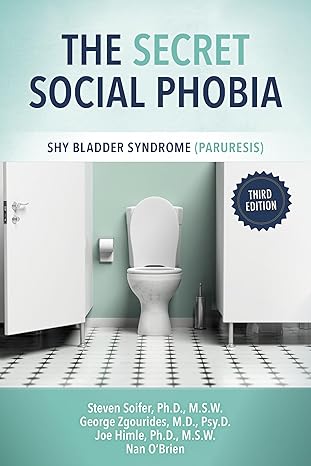A: In general, the similarities between women and men in terms of etiology, triggers, privacy issues, and treatment methods far outweigh the differences between the genders.
One major distinction is that while private stalls may be the back-up option for some men, they are the only option available for women – unless they have learned to pee in the wilds! A woman who cannot urinate in private stalls in restrooms only has self-catheterization to rely on as a fallback strategy. (Catheterization refers to inserting a small plastic tube into your urethral opening for purposes of releasing urine). For some women, learning to and feeling comfortable with this process may be enough to provide the security she needs to urinate anywhere. For other women, particularly those who have a moderate to severe case of paruresis and/or those who desire full recovery, it is not.
Female bathroom behavior is very different for women. Unlike men, women often enter public restrooms in packs, enjoying the social aspect when they congregate. Some talk between stalls; others linger in restrooms while they apply make-up or perhaps change a baby’s diaper. Some are accompanied by little children who can be disruptive when they share a stall with their mother.
People suffering from paruresis, in general, do not like to feel rushed. Women face the possibility of encountering long lines in often crowded bathrooms because there aren’t enough stalls. This may exacerbate the time pressure many report feeling when they enter a restroom. Many women with paruresis have heightened concerns about being visible to others when they’re using a stall, unless they’re fortunate to encounter a fully enclosed, ceiling-to-floor one. Some report feeling intimidated by the presence of an attendant in a bathroom, the likelihood of which is greater for women.
Noise affects women in different ways. Some seem ultra-sensitive to it, to the possibility of being “heard” while urinating, or to the presence of external noise in the restroom.
Given anatomical differences, the self-catheterization process is not the same for women as it is for men. It is highly recommended that women be taught by a knowledgeable health care practitioner, preferably a female, before attempting the process. There are different methods, but for practical purposes, it is useful to sit on or stand above a toilet and identify the opening to the urethra by “feel,” then insert a catheter, allowing the urine to drain into the toilet bowl. Assistive devices are also available which can help you identify the correct opening.
Also, all catheters are not created equal, and women may require one whose diameter is less, i.e., a 10 FR vs. a 16 FR. Catheters are available in a number of different styles, sizes, and materials. Anyone who decides to try them will need to experiment to find which kind works best. Click here for specific instructions and tips on catheter use for women.
Women are far more susceptible to urinary tract infections (UTIs or cystitis) than men, and this knowledge may act as a deterrent to the practice of self-catheterization by some. One woman in five develops a UTI during her lifetime, according to statistics from the National Kidney and Urologic Diseases Information Clearinghouse. In fact, in order to reduce the risk of urinary tract infections in the first place, women are advised to drink plenty of liquids, especially water, and to urinate frequently. Therein lies the “Catch 22” – a woman who is suffering from paruresis probably cannot do that. However, antibiotics (e.g., Bactrim, Septra) can be prescribed for use as a preventative or treatment to alleviate the symptoms of a UTI. In addition, phenazopyridine, an over-the-counter medication, can help reduce the burning and frequency of urination that may occur with it.
Besides self-catheterization, women can avail themselves of a few other non-invasive urinary products that may be of some help in bladder emptying. One product provides an alternative to restroom use. It is a urinary pouch which, when attached to one’s inner thigh, is completely hidden beneath loose fitting jeans or pants. A valve at the bottom of the pouch can be opened to allow urine to be emptied into a toilet bowl. Other products are available for women who find themselves in outdoor situations and may be comfortable peeing there. They are considered assistive devices, such as a funnel or medical-grade tubing, which can enable females to pee through the fly of their clothes while standing. Other such devices include disposable and portable urinal bags and female urinals that can be used in a car, boat, or when camping.




